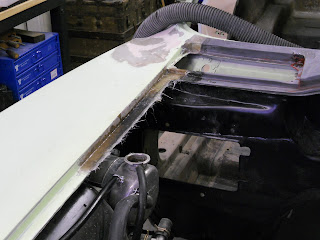Only a few days left to vote on the hood and racing stripe. Vote in the upper right corner.
While replacing the fresh air cowling I spotted a questionable section of fiberglass on the passenger side front fender hood lip. I ground out the area until it was paper thin.
Fresh fiberglass and resin were laid in and allowed to cure.
A little feathering brought it back to new.
The area is super strong and I am glad I repaired it. Better safe than sorry.
Our 1963 hood was purchased last year locally and it had been involved in a head on collision. When that happens to a C2 Corvette the front end of the car usually jambs the hood to the point that it can not be opened. Common practice is to use a reciprocating saw to remove the front end. Unfortunately, the hood often gets cut in the process and that's what happened to this hood. The hood has two cuts and this delamination.
The delamination was dressed up then bonding agent was applied.
While the clamps held the delamination the cut was feathered back then fiberglassed.
Both of the cuts to the hood were repaired.
Although the car is looking uglier by the day, it's getting better by the day. After we remove the old paint from the hood we will shoot everything with fresh primer.
Before long we will start installing Dynamat on the interior. This insulating and heat barrier needs a clean surface to adhere properly so I got out the Dewalt side grinder and a big wire brush.
The results are pretty impressive. This will take some time but I got a good start on it today.
Expect more on the hood, door jambs and drip rails. After that... Fresh Primer!










































